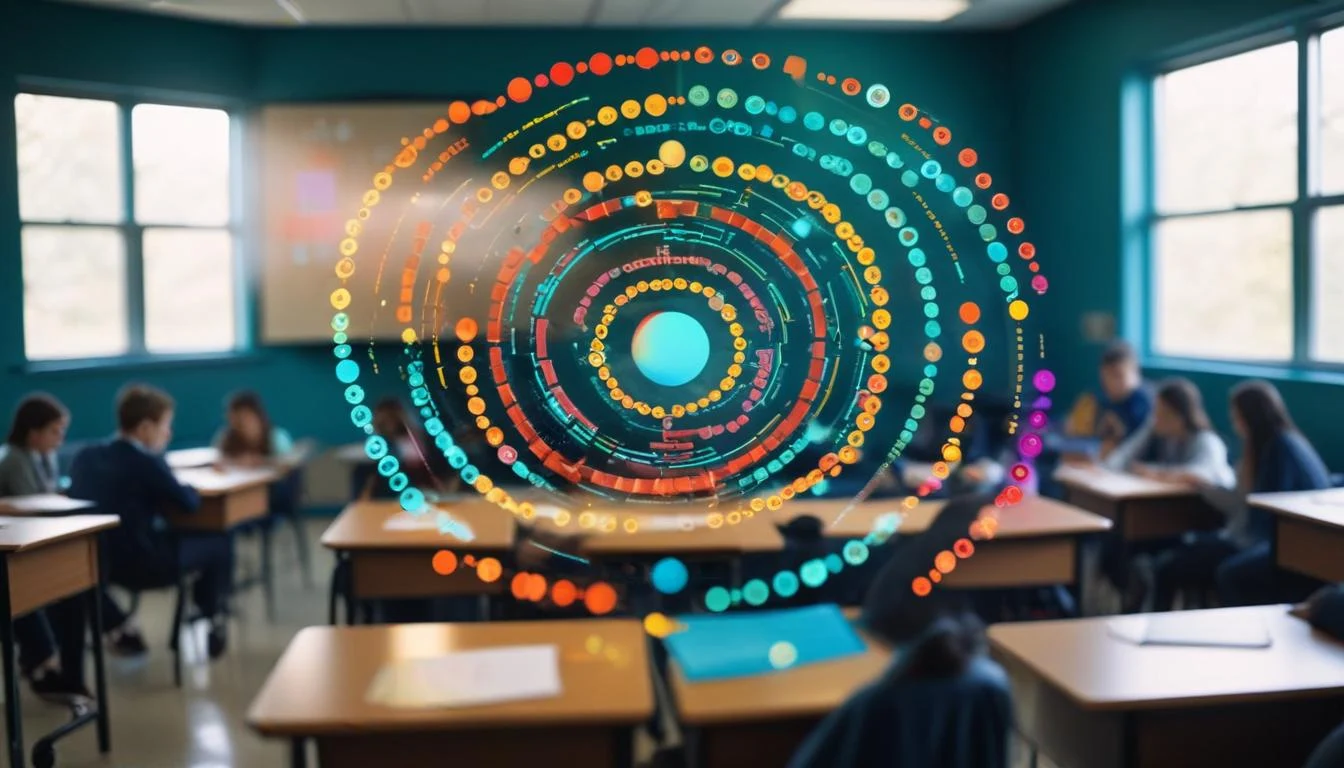 🔔 Affiliate Disclosure
This content may contain affiliate links. If you click on a link and make a purchase, we may receive a small commission — at no extra cost to you. Thank you for supporting BeatInsights! 💛
🔔 Affiliate Disclosure
This content may contain affiliate links. If you click on a link and make a purchase, we may receive a small commission — at no extra cost to you. Thank you for supporting BeatInsights! 💛
The rise of AI is transforming many fields. For instance, experts predict AI could boost the global economy by $15.7 trillion by 2030 PWC Website. Artificial Intelligence (AI) is when machines mimic human intelligence. This includes learning, problem-solving, and decision-making. Now, AI is entering education. Its importance grows daily. The purpose here is to explore the benefits, challenges, and Ethical Considerations for AI in Schools. Benefits of Artificial Intelligence in Education are huge. The article will also consider AI and Accessibility in Education. AI in Classroom Tools hold immense potential to personalize learning and improve education. The right AI-Powered Personalized Learning Platforms can improve the classroom. However, careful thought is vital when using it.
What are AI Classroom Tools?
AI in the context of education means using intelligent computer systems. These systems help students learn better. They also aid teachers in their work. AI-Powered Personalized Learning Platforms are a vital innovation. Several categories of tools exist. We can classify them by function.
- Personalized learning platforms tailor content.
- Automated grading systems score assignments.
- Intelligent tutoring systems give custom help.
- AI-powered content creation makes learning materials.
- Accessibility tools aid students with disabilities.
AI adapts to individual needs in education. It does so by assessing the student’s knowledge. The goal is to create a better learning experience.
Benefits of Artificial Intelligence in Education
AI offers many advantages in the classroom. These include personalized learning and increased teacher efficiency. Improved student engagement and enhanced accessibility are also benefits. Data-driven insights can transform teaching.
Personalized Learning Experiences
AI algorithms adapt to each student’s needs. They consider learning styles. Adaptive learning platforms change difficulty. This is based on student performance. If a student struggles, the system offers easier material. If a student excels, it gives harder tasks. This keeps students challenged at their level.

Increased Teacher Efficiency
AI can automate many teacher tasks. These include grading papers and planning lessons. AI can handle administrative work too. This frees up teachers’ time. They can then focus on student interaction. They can also offer individual support. It is important for teachers to use this time wisely.
Improved Student Engagement
AI can make learning more fun. Tools can add game-like elements. This is called gamification. Virtual reality can immerse students in subjects. AI also gives fast, personalized feedback. This keeps students interested and motivated.
Enhanced Accessibility
AI provides help for students with disabilities. Text-to-speech reads text aloud. Speech-to-text converts spoken words into writing. Real-time translation bridges language gaps. AI and Accessibility in Education are clearly linked.
Data-Driven Insights
AI gives teachers valuable data. This data shows student performance. Teachers can see where students struggle. They can then adjust their teaching. This targeted support boosts student success.
Examples of AI Classroom Tools
Several AI tools are now available for use. These tools are improving education. The tools provide various functions. They can boost learning.
Personalized Learning Platforms
- Khan Academy: This platform uses AI to personalize learning paths. It offers practice exercises and instructional videos. Subjects include math, science, and history.
- DreamBox Learning: DreamBox focuses on math education. Its AI adapts to each student’s understanding. It provides lessons at the right level. It is a good AI-Powered Personalized Learning Platforms.
Automated Grading Systems
- Gradescope: Gradescope uses AI to speed up grading. It works for handwritten work and code. It gives detailed feedback options.
- Crowdmark: Crowdmark is a system for collaborative grading. It allows multiple graders to assess work. This ensures consistency and fairness.
AI-Powered Tutoring Systems
- Duolingo: Duolingo uses AI to personalize language learning. It adjusts lessons to match your pace. It offers practice and rewards.
Ethical Considerations for AI in Schools
AI brings Ethical Considerations for AI in Schools. These include data privacy and algorithm bias. Over-reliance on AI and equitable access are concerns. Schools must address these issues.

Schools should also consider data security. It is important to protect student data. Privacy policies should be transparent.
Algorithm bias can lead to unfair outcomes. AI models can reflect the biases in their data. It is vital to monitor and correct these biases. This guarantees fairness in assessment and learning.
Over-reliance on AI could reduce critical thinking. Students may depend too much on technology. Educators must balance AI use with human interaction. This is to promote deeper learning.
Equitable access to AI is important. All students should benefit from these tools. This includes those from underserved communities. Schools need to ensure equal access.
AI has the potential to change education. Careful implementation is critical. Schools should address ethical concerns. This will ensure AI benefits all students fairly. They should also consider privacy when using AI.
Here’s the requested blog section in Markdown format:
Benefits of Artificial Intelligence in Education
The rise of artificial intelligence (AI) is transforming many fields, including education. Specifically, AI in Classroom Tools is creating new opportunities for personalized learning. AI-Powered Personalized Learning Platforms adapt to individual student needs, offering tailored instruction and support. These innovations bring many Benefits of Artificial Intelligence in Education. However, it’s essential to address Ethical Considerations for AI in Schools. Furthermore, AI and Accessibility in Education can help to provide more inclusive educational experiences.
AI-Powered Personalized Learning Platforms
AI offers many tools to personalize learning. Two system examples illustrate this well.
Third Space Learning and Personalized Math
Third Space Learning uses AI to personalize math learning. The platform provides one-on-one tutoring. It uses algorithms to assess a student’s strengths and weaknesses. The system then adapts the curriculum. This ensures students focus on areas where they need the most help. AI also analyzes student performance during sessions. This helps tutors provide targeted feedback and support. Moreover, Third Space Learning tracks progress. It uses data to refine its personalization strategies. Ultimately, this leads to better learning outcomes.

AI and Accessibility in Education
AI can boost accessibility in education. Several tools now exist to aid diverse learners. Two tools, Grammarly and Read&Write, demonstrate this.
Grammarly for Writing Improvement
Grammarly is an AI-powered writing assistant. It helps students improve their writing skills. The tool checks grammar and spelling. However, it also provides suggestions for style and clarity. Grammarly gives feedback on tone. It can help students communicate effectively. Students also get explanations for corrections. This helps them learn from their mistakes. Grammarly works across many platforms. This makes it a versatile tool for students. Moreover, it assists students with various writing tasks. From essays to emails, Grammarly can help.
Read&Write: A Comprehensive Support Tool
Read&Write is another tool enhancing accessibility. It offers several features to help students. Text-to-speech functionality reads text aloud. This benefits students with reading difficulties. A screen masking tool reduces distractions. Voice notes allow students to record audio feedback. Word prediction assists with writing. Read&Write offers vocabulary support. It defines words and provides images. The software also translates text. This supports students who are learning a new language. Read&Write aims to create an inclusive learning environment.
Challenges and Concerns of AI in Education
The use of AI in education is not without potential issues. Data privacy and security, algorithmic bias, and over-reliance on technology are critical concerns.
Data Privacy and Security
AI systems collect vast amounts of student data. This raises concerns about privacy and security. There are risks of data breaches and misuse. Protecting student data is crucial. GDPR and other regulations must be followed. Compliance is essential to maintaining trust. Furthermore, data should be anonymized when possible.
Bias and Fairness
AI algorithms can perpetuate existing biases. This can lead to unfair outcomes. Algorithms trained on biased data might discriminate. Certain student groups might be disadvantaged. Addressing bias is crucial for equity. Algorithms must be regularly audited for fairness.
Over-Reliance on Technology
Students may become too dependent on AI tools. This could hinder the development of critical thinking skills. It’s essential to balance AI with traditional methods. Students need to learn to think independently. Therefore, educators should promote critical thinking.
The Digital Divide
Unequal access to technology exacerbates inequalities. Students without access to devices or internet are disadvantaged. Closing the digital divide is crucial. All students deserve equal opportunities. Schools should provide resources to bridge this gap.
Cost and Implementation
Implementing AI tools can be expensive. Integrating them into curricula poses challenges. Financial burdens can be significant. Careful planning is essential. Funding may be required to support adoption.
Teacher Training and Support
Adequate training for teachers is essential. They need to use AI tools effectively. Ongoing support is crucial for success. Training programs should be comprehensive. Teachers need to understand AI’s capabilities.
Ethical Considerations
Ethical considerations are paramount. We must ensure AI is used responsibly. Transparency, accountability, and human oversight are key.
Transparency and Explainability
Understanding how AI algorithms work is vital. Ensure that AI is transparent and explainable. Black-box algorithms are problematic. We need to know why AI makes certain decisions. This promotes trust and accountability.
Accountability and Responsibility
Who is responsible when AI makes mistakes? This question must be answered. Clear lines of accountability are needed. Developers, educators, and policymakers share responsibility. We must address unintended consequences.
Human Oversight
Human oversight is essential. AI should augment, not replace, human judgment. Teachers must remain in control. AI should support their work, not dictate it. Human intervention is sometimes needed.
Impact on Teacher-Student Relationships
AI can impact teacher-student relationships. It’s important to preserve these relationships. AI should free up teachers to connect with students. It should not create distance or isolation.
Data Ownership
Who owns the data generated by AI tools? This issue needs clarification. Students should have control over their data. Data should be protected. Clear policies are required.
Promoting Equitable Access
Ensure all students benefit from AI. This includes students from all backgrounds. Address systemic inequities. Provide equal access to resources. Design AI tools that are inclusive.
The Future of AI in Education
AI is rapidly advancing. It promises significant changes in education.
Emerging Trends
Natural language processing is improving. Computer vision is also advancing. Predictive analytics offers new insights. These technologies will shape the future. They could impact personalized learning.
Personalized Learning at Scale
AI can enable personalized learning for all. Regardless of location or background, AI can help. This can be a reality with the right tools. These tools can adapt to the individual student.
AI-Powered Tutoring and Mentorship
AI can provide personalized tutoring. Mentorship opportunities can also be created. AI can fill gaps in traditional education. It offers support where needed most.
AI as a Collaborative Partner
AI can be a partner for teachers. It can augment their skills. This allows teachers to focus on complex tasks. It can free up valuable time.
Lifelong Learning
AI can support lifelong learning. It can offer personalized learning pathways. It offers resources for all ages. This promotes continuous growth.

Conclusion
AI has the potential to revolutionize education. However, challenges and ethical concerns must be addressed.
It’s crucial for educators, policymakers, and researchers to collaborate. They must develop and implement AI tools responsibly and equitably. Address challenges like data privacy and bias.
AI offers personalized learning, tutoring, and support. Emerging trends promise even more innovation. Working together, we can shape a better future for education. A future where every student has the opportunity to thrive with the support of Benefits of Artificial Intelligence in Education,Ai in Classroom Tools,AI-Powered Personalized Learning Platforms while we consider Ethical Considerations for AI in Schools,AI and Accessibility in Education.




